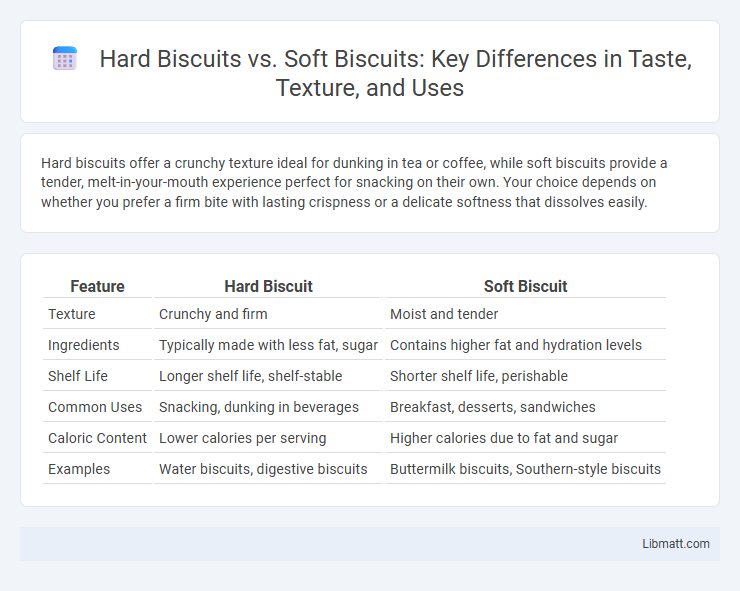Hard biscuits offer a crunchy texture ideal for dunking in tea or coffee, while soft biscuits provide a tender, melt-in-your-mouth experience perfect for snacking on their own. Your choice depends on whether you prefer a firm bite with lasting crispness or a delicate softness that dissolves easily.
Table of Comparison
| Feature | Hard Biscuit | Soft Biscuit |
|---|---|---|
| Texture | Crunchy and firm | Moist and tender |
| Ingredients | Typically made with less fat, sugar | Contains higher fat and hydration levels |
| Shelf Life | Longer shelf life, shelf-stable | Shorter shelf life, perishable |
| Common Uses | Snacking, dunking in beverages | Breakfast, desserts, sandwiches |
| Caloric Content | Lower calories per serving | Higher calories due to fat and sugar |
| Examples | Water biscuits, digestive biscuits | Buttermilk biscuits, Southern-style biscuits |
Introduction to Hard vs Soft Biscuits
Hard biscuits, characterized by their low moisture content and crisp texture, are ideal for long shelf life and dunking in beverages like tea or coffee. Soft biscuits contain higher moisture levels and often include ingredients like butter or milk, resulting in a tender, crumbly texture popular for snacking and desserts. The key differences lie in baking methods and ingredient composition, influencing texture, flavor, and usage.
Defining Hard Biscuits
Hard biscuits are characterized by their dry, dense texture achieved through minimal moisture content and longer baking times, resulting in a firm, crunchy bite. Common examples include digestive biscuits and ginger snaps, which are designed to maintain their shape and crispness over time. Their durability makes them ideal for pairing with hot beverages like tea or coffee, as they do not easily become soggy upon dipping.
What Makes a Biscuit Soft?
A biscuit's softness depends on the fat content and type, the liquid used, and the mixing technique. Soft biscuits typically contain butter or shortening and milk or buttermilk to create a tender, moist texture. Gentle mixing prevents gluten overdevelopment, resulting in a flaky and soft biscuit crumb.
Key Ingredients: Hard vs Soft Biscuits
Hard biscuits typically contain less moisture and higher amounts of sugar and fat, which contribute to their crisp texture and longer shelf life, while soft biscuits incorporate more butter, milk, and leavening agents like baking powder to produce a tender crumb and moist bite. The protein content in flour varies between the two, with hard biscuits often using all-purpose or bread flour for robustness versus soft biscuits favoring cake or pastry flour for a delicate softness. Managing the ratio of wet to dry ingredients is crucial in differentiating the firmness of hard biscuits from the fluffiness characteristic of soft biscuits.
Texture and Mouthfeel Differences
Hard biscuits have a firm, crunchy texture that provides a satisfying snap when bitten, offering a long-lasting mouthfeel that slowly dissolves in the mouth. In contrast, soft biscuits are tender and pliable, with a moist crumb that melts quickly, creating a smooth and delicate sensation. These textural differences influence their pairing with beverages, with hard biscuits complementing hot drinks by absorbing moisture, while soft biscuits deliver immediate, gentle flavor release.
Flavor Profiles Compared
Hard biscuits typically offer a denser texture with a rich, buttery flavor and subtle hints of caramelization, often enhanced by longer baking times that intensify their roasted notes. Soft biscuits feature a tender, flaky crumb with a lighter, milky sweetness and often include vanilla or cinnamon undertones, providing a more delicate and moist eating experience. The contrast in flavor profiles between hard and soft biscuits stems from variations in ingredient ratios and baking methods that influence texture and taste intensity.
Popular Uses for Hard and Soft Biscuits
Hard biscuits are commonly used in recipes requiring durability and texture, such as biscuit crumb bases for cheesecakes, ice cream toppings, and dippable snacks paired with tea or coffee. Soft biscuits find popularity in breakfast dishes and sandwiches due to their tender, flaky texture, often served with butter, jam, or sausage gravy. Both types cater to distinct culinary uses driven by their texture and moisture content, shaping their role in various meal contexts.
Shelf Life and Storage Insights
Hard biscuits typically have a longer shelf life due to their lower moisture content, making them ideal for long-term storage without refrigeration. Soft biscuits contain more moisture, which shortens their shelf life and requires airtight containers and cooler storage conditions to maintain freshness. For your pantry, choosing hard biscuits ensures extended usability and less concern over spoilage compared to soft biscuits.
Health and Nutritional Variations
Hard biscuits typically contain less moisture and often have a higher sugar and fat content, which can increase calorie density and impact blood sugar levels more significantly compared to soft biscuits. Soft biscuits usually have a higher moisture content and may include ingredients like milk and eggs, resulting in a softer texture and sometimes greater protein content. Your choice between hard and soft biscuits can influence digestion and nutrient absorption, with soft biscuits potentially offering more balanced nutrition depending on their recipe.
Choosing the Right Biscuit for You
Hard biscuits provide a longer shelf life and a satisfying crunch, making them ideal for dunking in hot beverages or adding texture to recipes. Soft biscuits offer a tender, moist bite, perfect for sandwiches or a quick snack that melts in your mouth. Your choice depends on whether you prioritize durability and crunch or softness and flavor absorption.
Hard Biscuit vs Soft Biscuit Infographic

 libmatt.com
libmatt.com